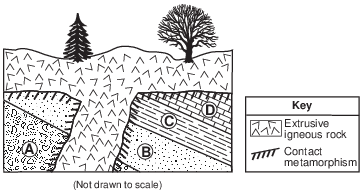Topic: Properties Of Common Minerals
Properties Of Common Minerals
Which rock is composed of a mineral that can be used for the production of cement?
(1) basalt
(2) limestone
(3) rock salt
(4) rock gypsum
The element silicon (Si) is used in the production of cell phones. Which mineral could be a possible source of this silicon?
(1) calcite
(2) galena
(3) halite
(4) quartz
The data table below gives characteristics of the gemstone peridot.

Peridot is a form of the mineral
(1) pyrite
(2) pyroxene
(3) olivine
(4) garnet
Which mineral is mined for its iron content?
(1) hematite
(2) fluorite
(3) galena
(4) talc
Which mineral is produced when two atoms of iron chemically combine with three atoms of oxygen?
(1) garnet
(2) pyrite
(3) magnetite
(4) hematite

Which two minerals have compositions that are most similar to calcite?
(1) brucite and carnallite
(2) carnallite and dolomite
(3) dolomite and magnesite
(4) magnesite and olivine
Mineral crystals of quartz, biotite mica, and amphibole are produced primarily by the
(1) chemical reaction of elements in seawater
(2) cooling and solidification of magma
(3) deposition of sediments by a glacier
(4) metamorphism of bituminous coal
Which two minerals are commercial sources of iron?
(1) galena and graphite
(2) muscovite mica and biotite mica
(3) garnet and fluorite
(4) hematite and magnetite
Which three minerals are most likely used in the construction of a house?
(1) graphite, pyrite, and halite
(2) garnet, galena, and sulfur
(3) talc, amphibole, and fluorite
(4) selenite gypsum, dolomite, and muscovite mica
Carrara Marble
Carrara marble is named for the town of Carrara on the west coast of Italy. This dazzling white marble has been mined since the time of the ancient Romans and remains the major industry of the area today. The marble has many commercial uses, such as tombstones, countertops, tiles, and building stones. Its chemical purity, uniform color, and hardness make this marble an ideal material for artists who carve statues from rock. Major museums around the world have statues carved from Carrara marble.
The formation of Carrara marble began 200 million years ago when a great thickness of tiny shells was deposited at the bottom of a warm, shallow sea. Over time, burial and compaction of these sediments formed sedimentary rock primarily composed of pure calcite. Approximately 27 million years ago, tectonic forces caused this area of the seafloor bedrock to be deformed and metamorphosed, forming the Carrara marble. Uplift and erosion later exposed huge formations of this famous marble.
In terms of mineral properties, explain why a statue is easier to carve from pure white marble rather than from pure white quartzite. [1]
Allow 1 credit. Acceptable responses include, but are not limited to:
• — The mineral that makes up quartzite is harder than the mineral that makes up marble.
• — The hardness of calcite is only 3 while the hardness of quartz is 7.
• — Marble is softer than quartzite because it is made of calcite, a softer mineral.

Identify one mineral in this rock sample that can scratch the mineral olivine. [1]
Allow 1 credit for garnet or quartz.

List the two elements that are commonly found in olivine, pyroxene, and potassium feldspar. [1]
_______________________________________ and _______________________________________
Allow 1 credit for silicon/Si and oxygen/O.

Identify the mineral composition of rock layer D. [1]
Allow 1 credit for calcite or CaCO3 or calcium carbonate.

Identify the primary chemical element found in coal. [1]
Allow 1 credit for carbon or C.
Describe one characteristic of the minerals in group A that makes them different from the minerals in group B. [1]
Group A:
Allow 1 credit. Acceptable responses include, but are not limited to:
• Group A:
• — lighter colored
• — more felsic
• — lower density
• — lacks magnesium/Mg/iron/Fe
• — rich in silicon/Si/aluminum/Al
